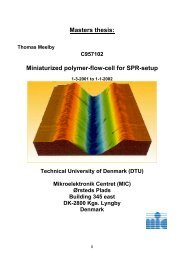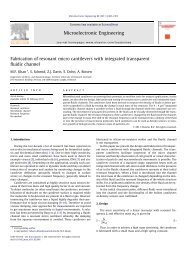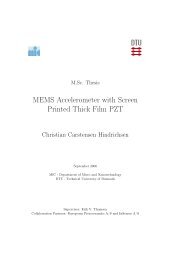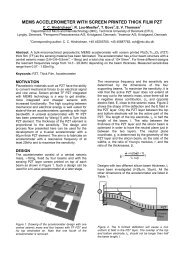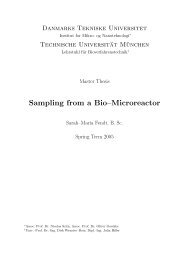Prototyping of microfluidic systems with integrated ... - DTU Nanotech
Prototyping of microfluidic systems with integrated ... - DTU Nanotech
Prototyping of microfluidic systems with integrated ... - DTU Nanotech
Create successful ePaper yourself
Turn your PDF publications into a flip-book with our unique Google optimized e-Paper software.
Chapter 4<br />
Fabrication methods<br />
4.1 Introduction<br />
During this project a number <strong>of</strong> different fabrication methods for micr<strong>of</strong>luidic<br />
structures have been employed. Some <strong>of</strong> the methods are<br />
well-known from macroscopic fabrication, and have simply been scaled<br />
down to the micrometer range. Others have come from the world <strong>of</strong><br />
silicon processing, and have been developed specifically for micro and<br />
nano scale fabrication. For all the methods, however, one factor is very<br />
important, namely the accuracy.<br />
Micro milling has been investigated by a lot <strong>of</strong> research groups, and<br />
has been characterised on machines weighing several tons and taking<br />
up a small room, and yet micro milling <strong>of</strong> structures <strong>with</strong> feature sizes<br />
down to tens <strong>of</strong> micrometer is possible because <strong>of</strong> the overall accuracy<br />
<strong>of</strong> the entire system. This precision is only possible, if all parts <strong>of</strong> the<br />
milling machine are produced <strong>with</strong> very small tolerances. Also, <strong>with</strong><br />
bulky equipment, thermal expansion must be taken into consideration,<br />
since a small relative thermal expansion or contraction can result in<br />
large deviations when comparing <strong>with</strong> the size <strong>of</strong> the tools used and the<br />
structures that are produced.<br />
When spin coating substances onto substrates, the area is macroscopic,<br />
typically some 100 cm 2 . The layer thickness, on the contrary, can<br />
go down to tens <strong>of</strong> nanometer, <strong>with</strong> nanometer accuracy. For metals,<br />
sputtering devices even allow deposition <strong>of</strong> ˚Angström-thin layers.<br />
In this chapter, a general introduction will be given to the fabrication<br />
and machining methods used in the project. Also, the experiences<br />
achieved through the work will be presented and commented. The<br />
35



